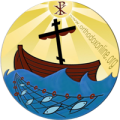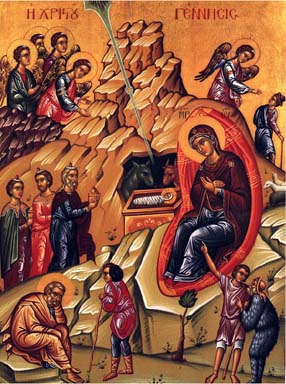 The icon before us presents the Gospel event clearly and simply to the eye. The event was conveyed in harmonious shapes and colors, as Saint Romanos, the psalmist, composed the holiday hymn, giving an eloquent summary of the event in poetry and music: “Today the virgin comes to the cave to give birth to the Sublime Substance...”
The icon before us presents the Gospel event clearly and simply to the eye. The event was conveyed in harmonious shapes and colors, as Saint Romanos, the psalmist, composed the holiday hymn, giving an eloquent summary of the event in poetry and music: “Today the virgin comes to the cave to give birth to the Sublime Substance...”
The icon brings together various events: the birth of Jesus, the annunciation of the shepherds, the visit of the Magi, the washing of the child, and others, and the number of people in it is not less than 15. However, it reaches perfection in terms of the harmony of colors and shapes, the sequence of scenes, and their connection to each other. The icon is characterized by movement. All the people are moving, doing something, saying something. Joseph is on the left, who appears to be motionless, with turbulent thoughts moving within him. Calmness in the middle of the icon: Jesus is in the manger and his mother is still, because through him true peace came to the world.
At the top of the icon, the triangular light descends from the circle (or triangle) of the divinity and forms the star that indicates the born child. Christmas is the Feast of Light, Christ the Sun of Justice. We find the same ray on the icon of the Divine Appearance, and there is no wonder about that. The two feasts are one feast, the feast of the appearance of the light of Christ our God. The Prophet Isaiah longed for the Lord’s presence to us when he said, “I wish you would rend the heavens and come down” (64:1). God answered his prayer by giving birth to Christ from the Virgin Mary through the Holy Spirit. Saint Gregory the Theologian said that Christmas is the holiday of new creation (re-creation). So how can the whole creation not rejoice with joy as we sing, “Rejoice, O inhabited world, when you hear, and glorify with the angels and shepherds who, by His will, will reveal a new child, and He is our God before the ages.”
We see the baby wrapped in swaddling clothes and placed in the manger. The painters intended for the swaddling clothes to resemble the shrouds in the icon of the empty tomb, which indicates the resurrection of Christ. The event of the incarnation is the event of salvation that occurred on the cross. The Gospels do not mention the cave. Tradition places birth in the cave in the midst of the darkness of sin and death as an expression of Christ’s victory over death. He is the one who bent the heavens so that the virgin became a throne, and we sinners were reconciled to God through her, as we chant in the holiday liturgy: “Our Savior has visited us from on high, from the rising of the east. We who are in darkness and shadows have found the truth because the Lord was born of the virgin.” The focus in the Gospel, rituals, and iconography is on the salvation of humans with the coming of Christ, and the Church does not stop at his appearance as a child. We sing heralds of the great news: “A new child has been born to us, the God who is before the ages.”
We see the Virgin Mary lying outside the cave, wearing royal purple. In most icons, she is not looking at her newborn son, but her gaze is immersed in contemplation of the Gospel of Salvation. She was the one who “kept all these words, pondering them in her heart” (Luke 2:19). She exists as the Mother of God, but she exists in her own right because, by accepting the angel's message, she made the divine incarnation possible. She is the new Eve, the mother of all humanity, and she represents the Church in many icons. Through it, the hope of the Jewish people reached its peak, and the long wait was shortened. Through her, the prophecies were fulfilled as she gave birth and remained a virgin because “she gave birth to an incarnated son without a father, who was born of the Father before the ages without a mother.” She was born contrary to the order of nature, as she remained a virgin. The Mother of God is drawn with a star on her head and a star on her right and left shoulder to indicate that she is a virgin before, during, and after birth. Mary represents us, as she is the greatest offering that man has made to God, as we chant on the evening of the feast: “What do we offer you, O Christ, because you appeared on earth as a human being for our sake?” Every single one of the creatures You created gives you thanks: the angels are praise, the heavens are stars, the Magi are gifts, the shepherds are marvels, the earth is a cave, and the desert is a manger, but we are a virgin...”
At the bottom of the icon we see Joseph immersed in deep contemplation. He is always away from the child and his mother because he is not the child's father. Joseph is astonished and perplexed by this supernatural birth, and the devil whispers doubt to him, so he is disturbed and doubts Mary, but when he was convinced by the angel of the Lord that this was the work of the Holy Spirit for the salvation of mankind, he believed in Jesus and took care of him (Matthew 1:18-23).
The presence of the donkey and the ox on Christmas icons also brings us back to the Prophet Isaiah: “The ox knows its owner, and the donkey is its owner’s feeder. As for Israel, he does not know. My people do not understand” (Isaiah 1:3). There are many explanations that interpret the bull that was sacrificed and the donkey that carried the king into Jerusalem as indications that Jesus is the awaited Messiah. He is the one about whom the Prophet Isaiah said: “He eats butter and honey. Before a boy knows good or evil, he rejects evil to choose good” (7:15).
The shepherds tend the sheep and look at the angel. They were the ones who conveyed the good news. This must remind us of Christ the Shepherd, and shed light on the words of the Lord, the Good Shepherd, who knows the sheep by name, calls them out, and gives them life.
Also at the bottom of the icon is the woman who washes Jesus to indicate the truth of the Lord’s incarnation, in refutation of the heresies that denied the incarnation of Christ. There is also the tree in which a fresh branch emerged from a withered trunk, as we chant: “A rod has come forth from the stem of Jesse, and from it has grown a flower” (Isaiah 11:1-2).
We see the Magi riding horses whose movements pulse with life and speed, carrying “those who bow down to the stars... who come forward to you as the first of the nations.” They carry gifts and look at the star that appeared to them in the East and led them to Bethlehem. They are the ones who “learned from the planet to prostrate to you, O Sun of Justice.”
We see the angels at the top of the icon wearing red, golden clothes that reflect the glory of divinity. On the left, their eyes are looking up and their hands are raised to the heights, offering God endless praise. As for the angel on the right, he bows toward the shepherd, giving good tidings. The dual role of angels appears here: serving humans and unceasing praise.
After this contemplation of the icon in the atmosphere of holiday joy, let us sing good tidings of salvation to all peoples: “Christ was born, so glorify him. Christ came from the heavens, so they received him. Christ was on earth, so they were exalted. Sing to the Lord, O whole earth, and O peoples, praise Him with joy, for He has been glorified.”
Quoted from my parish bulletin 1996

